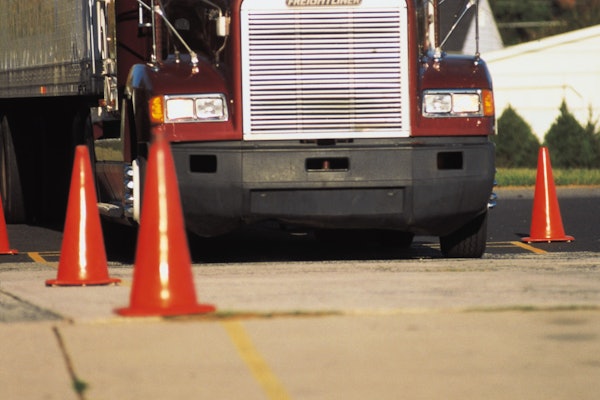Trucking news and briefs for Tuesday, Aug. 27, 2024:
Two of nation’s worst freight bottlenecks getting makeover
Work will soon begin on a stretch of Atlanta-area interstate the Georgia Department of Transportation hopes will help unclog one of the worst freight bottlenecks in the U.S.
The annual Top Truck Bottleneck List compiled by the American Transportation Research Institute (ATRI) measures the level of truck-involved congestion at more than 325 locations on the national highway system, and the Interstate 20/I-285 interchange consistently ranks among the worst.
 The I-285/I-20 West interchange was ranked No. 6 in the ATRI's 2024 Top 100 Truck Bottlenecks list.GDOT
The I-285/I-20 West interchange was ranked No. 6 in the ATRI's 2024 Top 100 Truck Bottlenecks list.GDOT
The I-285/I-20 West Interchange limits begin along I-20, from the Factory Shoals Road overpass to the Hamilton E. Holmes Drive interchange, for six miles. Along I-285, the $1.2 billion project begins just south of the Donald Lee Hollowell Parkway interchange and ends at the MLK Jr. Drive interchange, for two miles. The project will reconstruct and widen several interstate system-to-system ramps and add a combination of collector-distributor/connecting lanes and auxiliary lanes along I-20 west and I-285 north of the interchange.
Proposed improvements to the interchange include:
- The removal of left-hand ramp entrance and exit ramps from interchange
- Improvement of geometric design and vertical grades
- Construction of two-lane ramps within the interchange
- Construction of westbound collector-distributor lanes, or connecting lanes, from I-285/I-20 West Interchange to Fulton Industrial Boulevard
- Adding lanes along I-20 from Factory Shoals Road to Hamilton E. Holmes Drive
- Adding lanes along I-285 from Donald Lee Hollowell Parkway south to MLK Jr. Drive to accommodate interchange improvements
- Modifying/replacing bridge structures and ramps in interchange and along I-20, including those over the Fulton County Railway (CSX RR) and the Chattahoochee River

Georgia DOT expects construction to begin next year with substantial completion expected in 2030.
[Related: The worst truck bottlenecks in America deliver $95 billion in congestion costs]
 The east interchange was ranked No. 21 on ATRI's list.GDOT
The east interchange was ranked No. 21 on ATRI's list.GDOT
For the East interchange, Georgia DOT and its construction partners implemented a long-term traffic shift Tuesday, Aug. 27 on I-20 westbound, as part of the I-285/I-20 East Interchange project. The I-20 shift between the Miller Road overpass and Wesley Chapel Road facilitates ongoing bridge construction and widening in the corridor, GDOT said.
Starting at Panola Road, motorists traveling I-20 westbound can expect a 50-foot lane shift right to new Snapfinger Creek bridge sections and will then transition back to the existing mainline lanes approaching Wesley Chapel Road. To guide drivers to the new temporary alignment, I-20 will be re-striped, raised pavement markings added, and temporary barrier wall placed.
To maintain all three lanes on I-20, the work to widen and replace this bridge is happening in phases. In this initial phase, crews constructed a new bridge adjacent to the existing westbound bridge. Elsewhere on the I-285/I-20 East Interchange project, construction on the new flyover bridges within the interchange continues with concrete pours ongoing for bridge bents.
Crews recently completed the placement of steel girders over I-20 eastbound for the new I-285 southbound to I-20 eastbound bridge ramp. The first concrete pours for the new bridge over I-20 at Fairington Road and Hillandale Drive were recently finished as well.
Following weeks of rock blasting, activities supporting a new I-20 westbound auxiliary lane, eastbound collector-distributor lane, or connecting lane, along with paving and barrier wall construction continue throughout the corridor.
FMCSA awards $3.5 million to trucking schools
The Federal Motor Carrier Safety Administration announced this week that it has awarded nearly $3.5 million to 27 colleges and other CDL training programs through the agency’s Commercial Motor Vehicle Operator Safety Training (CMVOST) grant program.
FMCSA said the grants will help improve roadway safety by providing additional training for current CDL holders and creating new pathways for career opportunities as drivers in the commercial motor vehicle industry.
“The Biden-Harris Administration’s investments in training and support for Commercial Driver’s License holders will help meet the nation’s growing demand for truck drivers and better prepare for the future,” said U.S. Transportation Secretary Pete Buttigieg. “The funding we’re announcing today is an important part of this Administration’s Trucking Action Plan to strengthen America’s supply chains and support the workers who keep our economy moving.”
The CMVOST grant program has three goals:
- Expand the number of CDL holders possessing enhanced operator safety training
- Provide opportunities for current or former members of the United States Armed Forces (including National Guard members and reservists) and certain family members to enter the trucking or busing industry as drivers
- Help increase the training opportunities for candidates from rural, refugee, and underserved communities
“At FMCSA, our job is all about safety – that includes safety of the roadways and safety of our nation’s commercial motor vehicle drivers,” said FMCSA Deputy Administrator Vinn White. “So, we are proud to make this funding available, and are committed to working with the awardees to put it to good use, making it easier for drivers to enter into and stay in the CMV industry.”
A full list of CMVOST grants can be found here.
Market conditions deteriorated for shippers in June: FTR
Market conditions for shippers took a big hit in June due to a variety of freight-related factors, according to FTR.
FTR’s Shippers Conditions Index (SCI) for June fell to 0.3 from the May reading of 4.5 as moderating fuel costs kept the index out of marginally negative territory.
FTR’s SCI forecast is for a prolonged phase of near-neutral readings, indicating a mostly balanced freight market between shippers and carriers.
“The days of consistently favorable freight market conditions for shippers are over, but the market does not really look tough for them, either,” said Avery Vise, FTR’s vice president of trucking. “Over the forecast horizon, we do not expect the market to be even remotely as challenging as the one that shippers endured from late 2020 through mid-2022, and shippers might even fare better than they anticipate. The biggest wild card in the near term probably is the cost of fuel.”
June’s reading was the SCI’s lowest since it landed in negative territory in February.













